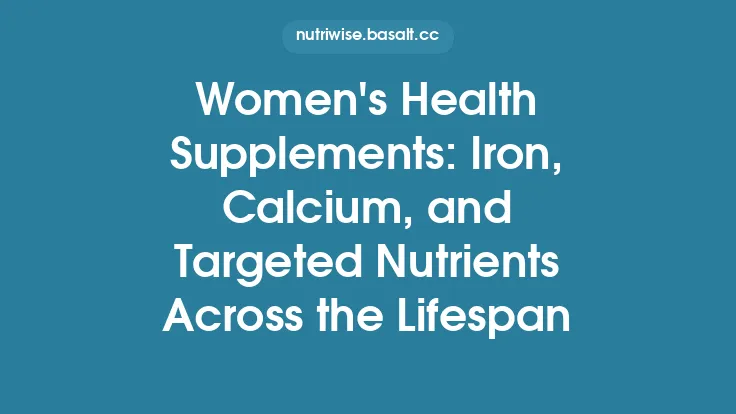The transition into perimenopause and menopause brings a cascade of hormonal fluctuations that reshape a woman’s nutritional landscape. While many women focus on macronutrient balance and weight management during this phase, the subtle yet powerful influence of micronutrients often determines how smoothly the body navigates hot flashes, bone remodeling, mood shifts, and metabolic changes. Understanding which vitamins and minerals become especially critical, how they interact, and how to tailor intake to individual health profiles can empower women to maintain vitality, protect long‑term health, and reduce the risk of chronic conditions that tend to emerge later in life.
Hormonal Shifts and Their Micronutrient Implications
Estrogen Decline:
- Bone health: Estrogen helps preserve bone density by regulating calcium absorption and inhibiting osteoclast activity. As estrogen wanes, calcium loss accelerates, making vitamin D, magnesium, and vitamin K2 essential co‑factors for bone remodeling.
- Neurotransmitter synthesis: Estrogen modulates serotonin and dopamine pathways; B‑vitamins (especially B6, B9, B12) are required for the synthesis of these neurotransmitters, influencing mood and cognitive function.
Progesterone Fluctuations:
- Progesterone has a mild diuretic effect and can affect fluid balance. Adequate potassium and magnesium help mitigate bloating and muscle cramps often reported during perimenopause.
Increased Oxidative Stress:
- The loss of estrogen’s antioxidant properties heightens oxidative stress, which can exacerbate hot flashes and cardiovascular risk. Antioxidant micronutrients such as vitamin C, vitamin E, selenium, and polyphenol‑rich foods become more protective.
Metabolic Rate Adjustments:
- A modest decline in resting metabolic rate is common. B‑vitamins, chromium, and zinc support efficient carbohydrate metabolism and insulin sensitivity, helping to maintain healthy body composition.
Core Micronutrients for Perimenopausal and Menopausal Women
| Micronutrient | Primary Functions in This Life Stage | Recommended Dietary Allowance (RDA) / Adequate Intake (AI) | Key Food Sources | Supplementation Notes |
|---|---|---|---|---|
| Calcium | Bone mineralization; muscle contraction | 1,200 mg (women ≥ 51 y) | Low‑fat dairy, fortified plant milks, leafy greens (collard, bok choy), sardines with bones | Pair with vitamin D for optimal absorption; avoid excessive calcium (>2,500 mg) without medical supervision. |
| Vitamin D | Enhances calcium absorption; modulates immune function; influences mood | 800–1,000 IU (20–25 µg) for adults ≥ 50 y (may need higher based on serum 25(OH)D) | Fatty fish, egg yolk, fortified dairy/plant milks, UV‑exposed mushrooms | Check serum 25(OH)D; consider 1,000–2,000 IU daily if levels <30 ng/mL. |
| Magnesium | Cofactor for over 300 enzymatic reactions; supports bone health, sleep, and muscle relaxation | 320 mg (women ≥ 31 y) | Nuts (almonds, cashews), seeds (pumpkin, chia), whole grains, legumes, dark chocolate | Split doses (e.g., 200 mg twice daily) to improve tolerance; avoid high‑dose magnesium oxide unless prescribed. |
| Vitamin K2 (Menaquinone) | Directs calcium to bone and teeth, away from arteries; synergizes with vitamin D | No established RDA; AI ~90 µg (based on limited data) | Natto, fermented cheeses, egg yolk, chicken liver | May interact with anticoagulants (warfarin); monitor INR if on therapy. |
| Vitamin B12 (Cobalamin) | Red blood cell formation; neurological health; methylation pathways | 2.4 µg | Animal products (meat, fish, dairy), fortified cereals, nutritional yeast | Absorption declines with age; consider sublingual or injectable forms if serum B12 <300 pg/mL. |
| Folate (Vitamin B9) | DNA synthesis; supports cardiovascular health via homocysteine reduction | 400 µg DFE (dietary folate equivalents) | Dark leafy greens, legumes, citrus, fortified grains | For women on certain anti‑seizure meds, higher intake may be needed. |
| Vitamin C | Antioxidant; collagen synthesis (skin, blood vessels); enhances iron absorption | 75 mg (women ≥ 19 y) | Citrus fruits, berries, kiwi, bell peppers, broccoli | High doses (>2 g) can cause GI upset; moderate intake is sufficient for antioxidant benefit. |
| Vitamin E (α‑tocopherol) | Lipid‑soluble antioxidant; protects cell membranes | 15 mg (22.4 IU) | Nuts, seeds, spinach, avocado, wheat germ oil | Excess >1,000 IU may increase bleeding risk; stay within recommended range. |
| Selenium | Selenoproteins involved in thyroid hormone metabolism and antioxidant defense | 55 µg | Brazil nuts (1–2 nuts provide >100 µg), seafood, whole grains | Avoid chronic high intake (>400 µg) due to selenosis risk. |
| Zinc | Immune function; taste perception; hormone synthesis | 8 mg (women ≥ 19 y) | Oysters, beef, pumpkin seeds, chickpeas, fortified cereals | High zinc (>40 mg) can interfere with copper status; balance with copper if supplementing long‑term. |
| Iron | Prevents anemia; supports energy metabolism | 8 mg (post‑menopausal) – 18 mg (pre‑menopausal) | Red meat, poultry, lentils, fortified cereals, spinach (non‑heme) | Post‑menopause, excess iron may increase oxidative stress; monitor ferritin. |
| Omega‑3 Fatty Acids (EPA/DHA) | Anti‑inflammatory; supports cardiovascular health; may reduce hot flash frequency | 250–500 mg combined EPA+DHA | Fatty fish (salmon, mackerel), algae oil, walnuts, flaxseed | Plant‑based ALA (α‑linolenic acid) conversion to EPA/DHA is limited; consider algae‑derived DHA supplement for vegans. |
Micronutrient Interactions and Absorption Nuances
- Calcium–Magnesium Balance: Both compete for intestinal transporters. A ratio of roughly 2:1 (calcium:magnesium) is often recommended to avoid magnesium deficiency while ensuring adequate calcium.
- Vitamin D–Magnesium Synergy: Magnesium is required for the enzymatic conversion of vitamin D into its active form (calcitriol). Low magnesium can blunt the benefits of vitamin D supplementation.
- Iron–Vitamin C Pairing: Vitamin C reduces ferric (Fe³⁺) to ferrous (Fe²⁺) iron, markedly improving non‑heme iron absorption. Pairing iron‑rich plant foods with citrus or bell peppers is a simple strategy.
- Zinc–Copper Antagonism: High supplemental zinc can induce copper deficiency, leading to anemia and neutropenia. A common practice is to include 1–2 mg copper for every 30 mg zinc supplemented.
- Vitamin K2–Vitamin D–Calcium Triad: Vitamin K2 activates osteocalcin, directing calcium to bone matrix, while vitamin D enhances calcium absorption. Adequate intake of all three reduces the risk of vascular calcification.
Dietary Patterns that Naturally Support Micronutrient Needs
| Pattern | Why It Works for Perimenopause/Menopause | Practical Tips |
|---|---|---|
| Mediterranean‑style | Emphasizes leafy greens, nuts, fish, and olive oil—rich sources of calcium, magnesium, vitamin K2, omega‑3s, and antioxidants. | Aim for ≥2 servings of fatty fish weekly; incorporate a daily handful of nuts and seeds. |
| Plant‑forward with fortified foods | Provides fiber, phytoestrogens (isoflavones) that may modestly alleviate hot flashes, plus fortified calcium and vitamin D. | Choose calcium‑fortified plant milks, tofu set with calcium sulfate, and fortified cereals. |
| Balanced macro‑micronutrient meals | Ensures each meal contains a protein source (for B‑vitamins), a colorful vegetable (vitamins C, K, folate), and a healthy fat (fat‑soluble vitamins). | Use the “plate method”: ½ vegetables, ¼ lean protein, ¼ whole grains, plus a drizzle of olive oil or a few nuts. |
| Low‑glycemic, high‑fiber | Stabilizes blood glucose, reducing insulin spikes that can exacerbate hormonal symptoms. Fiber also supports magnesium and B‑vitamin absorption. | Prioritize whole grains (quinoa, barley), legumes, and abundant non‑starchy vegetables. |
Supplementation: When, How, and What to Watch For
- Baseline Assessment: Before initiating any supplement regimen, obtain a comprehensive blood panel (25‑OH vitamin D, serum calcium, magnesium, ferritin, B12, folate, zinc, and thyroid function).
- Targeted Supplementation:
- *Vitamin D*: If serum 25‑OH D <30 ng/mL, start with 1,000–2,000 IU daily; re‑check after 8–12 weeks.
- *Calcium*: Prefer food sources; supplement only if dietary intake <1,000 mg. Use calcium citrate (better absorption without stomach acid) rather than calcium carbonate if on acid‑suppressing meds.
- *Magnesium*: 200–400 mg of magnesium glycinate or malate split into two doses to improve tolerance.
- *B‑Complex*: Choose a methylated B‑complex (containing methylcobalamin and 5‑methyltetrahydrofolate) for better bioavailability, especially in women with MTHFR polymorphisms.
- *Omega‑3*: 1,000 mg EPA+DHA daily; consider algae‑derived DHA for vegetarians.
- Safety Checks:
- Avoid high‑dose vitamin E (>400 IU) if on anticoagulants.
- Monitor serum calcium if taking calcium plus vitamin D; hypercalcemia can cause kidney stones.
- Women with a history of breast cancer should discuss phytoestrogen‑rich foods and supplements with their oncologist.
Monitoring Progress and Personalizing Intake
- Quarterly Symptom Diary: Track hot flash frequency, sleep quality, mood swings, and joint discomfort. Correlate changes with dietary adjustments or new supplements.
- Annual Lab Review: Repeat the baseline panel; adjust dosages based on trends (e.g., rising ferritin may signal excess iron).
- Bone Density Scans (DEXA): Recommended every 1–2 years after menopause onset, especially if calcium or vitamin D intake is borderline.
- Genetic Considerations: Testing for MTHFR, CYP1A2 (affects caffeine metabolism), and VDR (vitamin D receptor) variants can refine micronutrient recommendations.
Lifestyle Factors that Amplify Micronutrient Benefits
- Weight‑bearing Exercise: Resistance training and brisk walking stimulate osteoblast activity, making calcium and vitamin D more effective for bone health.
- Stress Management: Chronic cortisol elevation can deplete magnesium and B‑vitamins. Incorporate mindfulness, yoga, or deep‑breathing practices to preserve these stores.
- Adequate Sleep: Sleep deprivation impairs vitamin D metabolism and increases oxidative stress; aim for 7–9 hours of quality sleep.
- Limit Alcohol & Caffeine: Excessive alcohol interferes with calcium balance and vitamin D activation; high caffeine can increase urinary calcium loss. Moderation (≤1 drink/day, ≤300 mg caffeine) is advisable.
Special Situations
| Situation | Micronutrient Focus | Adjustments |
|---|---|---|
| Surgical Menopause (oophorectomy) | Accelerated bone loss; abrupt estrogen drop | Higher calcium (1,200–1,500 mg) and vitamin D (2,000 IU) for the first year; consider bisphosphonate therapy if indicated. |
| Ethnic Variations | African‑American women often have higher bone density but may have lower vitamin D synthesis due to melanin. | Emphasize vitamin D supplementation (2,000 IU) and monitor serum levels closely. |
| Concurrent Chronic Conditions (e.g., Type 2 Diabetes, Hypertension) | Increased need for magnesium, chromium, and potassium; caution with sodium‑rich processed foods. | Prioritize magnesium‑rich foods, low‑sodium diets, and consider chromium picolinate (200 µg) under medical guidance. |
| Vegetarian/Vegan Diets | Potential gaps in B12, iron (heme), calcium, DHA/EPA, zinc. | Use fortified foods, B12 sublingual tablets (≥500 µg weekly), algae‑derived DHA/EPA, and consider zinc citrate (8 mg) with copper balance. |
Practical Meal‑Planning Blueprint
- Breakfast: Greek yogurt (calcium, vitamin D) topped with chia seeds (magnesium, omega‑3) and berries (vitamin C, antioxidants).
- Mid‑Morning Snack: Handful of almonds (magnesium, vitamin E) and a small orange (vitamin C).
- Lunch: Quinoa salad with roasted salmon (EPA/DHA, vitamin D), kale (vitamin K, calcium), cherry tomatoes, and olive‑oil‑lemon dressing (healthy fats for fat‑soluble vitamin absorption).
- Afternoon Snack: Carrot sticks with hummus (zinc, iron) and a cup of fortified plant milk (calcium, vitamin D).
- Dinner: Stir‑fried tofu (calcium set with calcium sulfate) with broccoli, bell peppers, and brown rice; sprinkle sesame seeds (copper, magnesium).
- Evening: Warm milk (dairy or fortified soy) with a dash of turmeric (anti‑inflammatory) and a small piece of dark chocolate (magnesium, iron).
Tip: Rotate protein sources (fish, poultry, legumes, tempeh) to cover a broader spectrum of B‑vitamins and trace minerals.
Frequently Asked Questions
Q: Can micronutrient supplements replace a balanced diet?
A: No. Whole foods provide synergistic nutrient matrices, fiber, and phytochemicals that supplements cannot fully replicate. Supplements should fill gaps, not serve as the primary source.
Q: How much calcium is too much?
A: Intakes above 2,500 mg/day (for women ≤50 y) or 2,000 mg/day (≥51 y) have been linked to kidney stones and possible cardiovascular calcification, especially without adequate vitamin K2 and magnesium.
Q: Do phytoestrogens (soy, flax) affect micronutrient needs?
A: Phytoestrogens can modestly influence estrogen receptors, potentially reducing hot flash severity. They also contain isoflavones that may compete with iron absorption; pairing soy with vitamin C‑rich foods mitigates this effect.
Q: Should I get a bone density scan before starting supplements?
A: Not necessarily, but if you have risk factors (family history of osteoporosis, early menopause, low body weight), a baseline DEXA can guide the intensity of calcium and vitamin D interventions.
Q: Is it safe to take a multivitamin that includes iron after menopause?
A: Post‑menopausal women generally need less iron. Unnecessary iron can accumulate and increase oxidative stress. Choose a multivitamin formulated for women over 50 that omits iron or contains a low dose (≤8 mg).
Bottom Line
Perimenopause and menopause are not merely a passage of time; they are a physiological crossroads where micronutrient adequacy becomes a decisive factor for bone integrity, cardiovascular health, cognitive function, and overall quality of life. By focusing on a targeted suite of vitamins and minerals—calcium, vitamin D, magnesium, vitamin K2, B‑vitamins, antioxidants, and omega‑3 fatty acids—women can proactively counteract the challenges posed by hormonal decline. Coupling these nutrients with a nutrient‑dense dietary pattern, regular physical activity, stress‑reduction practices, and personalized monitoring creates a resilient foundation that supports thriving health well beyond the menopausal transition.





